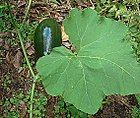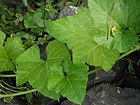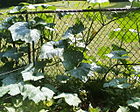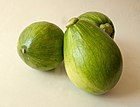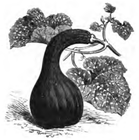Note: This is a project under development. The articles on this wiki are just being initiated and broadly incomplete. You can Help creating new pages.
Difference between revisions of "Cucurbita moschata - Butternut"
(Created page with "thumb|right|''Juglans cinerea'', ''Butternut'' '''Butternut''', commonly known as '''Juglans cinerea or white walnut''', is a species of walnut nat...") |
|||
| (34 intermediate revisions by 3 users not shown) | |||
| Line 1: | Line 1: | ||
| − | [[File: | + | [[File:Mittha Kaddu (Punjabi- ਮਿੱਠਾ ਕਦੂੱ) (5132851842).jpg|thumb|right|''Dangara balli'']] |
| + | '''Squash''' is an annual climbing plant. That can produce stems up to 5 metres long. The plant is widely cultivated, especially in warm temperate and tropical areas. It is also an important leaf vegetable in Africa, supplies a popular edible seed and has a wide range of medicinal uses. | ||
| + | ==Uses== | ||
| + | {{Uses|Abdominal cramps}}, {{Uses|Intestinal worms}}, {{Uses|Tape worm}}, {{Uses|Reddish blotches}}, {{Uses|Haemorrhages}}, {{Uses|Jaundice}}, {{Uses|Headache}}, {{Uses|Ophthalmia}}, {{Uses|Kinds of tumours}} | ||
| − | + | ==Parts Used== | |
| + | {{Parts Used|Flowers}}, {{Parts Used|Seeds}}, {{Parts Used|Leaves}}, {{Parts Used|Young stems}}, {{Parts Used|Fruits}} | ||
| − | == | + | ==Chemical Composition== |
| − | + | The lipids isolated from the seeds included glycerides, sterol esters, phosphatidylcholine and phosphatidylinositol.<ref name="chemical composition"/> | |
| − | |||
| − | + | ==Common names== | |
| + | {{Common names|kn=ಸಿಹಿ ಕುಂಬಳ ಕಾಯಿ Sihi kumbala kaayi|ml=Kumpalam|sa=|ta=Pucani|te=Gummadi|hi=Halwa kaddu|pa=Halwa kaddu|en=Butternut Pumpkin, Butternut Squash}}<ref name="Common names"/> | ||
| − | + | ==Properties== | |
| + | Reference: Dravya - Substance, Rasa - Taste, Guna - Qualities, Veerya - Potency, Vipaka - Post-digesion effect, Karma - Pharmacological activity, Prabhava - Therepeutics. | ||
| + | ===Dravya=== | ||
| − | == | + | ===Rasa=== |
| − | + | ===Guna=== | |
| − | |||
| − | |||
| − | |||
| − | == | + | ===Veerya=== |
| − | + | ===Vipaka=== | |
| + | ===Karma=== | ||
| + | |||
| + | ===Prabhava=== | ||
| + | |||
| + | ==Habit== | ||
| + | {{Habit|Climber}} | ||
| + | |||
| + | ==Identification== | ||
| + | ===Leaf=== | ||
| + | {{Leaf|Simple|Prostrate|Internodes to 10 cm, scabrous. Leaves 5-7-lobed, 16 x 24 cm, velvety, lobes acute; petiole to 15 cm}}<ref name="Leaf"/> | ||
| + | |||
| + | ===Flower=== | ||
| + | {{Flower|Unisexual|8 cm wide|Pale yellow|Stamens 3|Flowers Season is June - August}} | ||
| + | |||
| + | ===Fruit=== | ||
| + | {{Fruit|Stamens 3|6 cm||Fruit oblong, contracted in the middle|Seeds numerous, to 12 x 8 mm}} | ||
| + | |||
| + | ===Other features=== | ||
| + | |||
| + | ==List of Ayurvedic medicine in which the herb is used== | ||
| + | |||
| + | ==Where to get the saplings== | ||
| + | ==Mode of Propagation== | ||
| + | {{Propagation|Seeds}}. | ||
| + | |||
| + | ==How to plant/cultivate== | ||
| + | The plant can be grown from the temperate zone to the tropics, so long as there is a warm growing season of at least 150 days<ref name="How to plant/cultivate"/> | ||
| + | |||
| + | ==Commonly seen growing in areas== | ||
| + | {{Commonly seen|Tropical area}}, {{Commonly seen|South America}}, {{Commonly seen|North America}}. | ||
| + | |||
| + | ==Photo Gallery== | ||
| + | <gallery class="left" caption="" widths="140px" heights="140px"> | ||
| + | 001 ayote.jpg | ||
| + | Butternut Pumpkin (5132168765).jpg | ||
| + | Calabasa vine.jpg | ||
| + | Calabazas del centro de Argentina - pedúnculos de Cucurbita argyrosperma "Calabaza" y C. moschata "Anco", según Millán 1968.svg | ||
| + | Calabazas del centro de Argentina 1 - Cucurbita moschata "Anco" pedúnculo, según Millán 1968.svg | ||
| + | Chosun squash.jpg | ||
| + | Close up of Pumpkin, Halfsliced (Scientifc Name Cucurbita maxima).jpg | ||
| + | Courge cou tors du Canada Vilmorin-Andrieux 1883.png | ||
| + | Courge de Yokohama Vilmorin-Andrieux 1883.png | ||
| + | Courge.jpg | ||
| + | </gallery> | ||
| + | |||
| + | ==References== | ||
| + | |||
| + | <references> | ||
| + | <ref name="chemical composition">[http://gbpihedenvis.nic.in/PDFs/Glossary_Medicinal_Plants_Springer.pdf Chemical composition]</ref> | ||
| + | <ref name="Leaf">[https://indiabiodiversity.org/species/show/244545 Diagnostic]</ref> | ||
| + | <ref name="Common names">[https://sites.google.com/site/indiannamesofplants/via-species/c/cucurbita-moschata Common names]</ref> | ||
| + | |||
| + | |||
| + | <ref name="How to plant/cultivate">[http://practicalplants.org/wiki/Agrimonia_eupatoria Cultivation]</ref> | ||
| + | </references> | ||
| + | |||
| + | ==External Links== | ||
| + | * [https://www.ncbi.nlm.nih.gov/pubmed/17511465 Chemical composition and antioxidant activity of an acidic polysaccharide extracted from Cucurbita moschata Duchesne ex Poiret] | ||
| + | * [http://pubs.sciepub.com/plant/3/1/3/index.html Agromorphological, Chemical and Biochemical Characterization of Pumpkin] | ||
| + | * [http://eol.org/pages/584408/overview Cucurbita moschata on encyclopedea of life] | ||
| + | * [https://www.britannica.com/plant/Cucurbita-moschata Cucurbita moschata on encyclopedea britanicca] | ||
| + | |||
| + | * [https://www.cabi.org/isc/datasheet/17068Cucurbita moschata on cookies on invasive Species Compendium] | ||
[[Category:Herbs]] | [[Category:Herbs]] | ||
| + | [[Category:Ayurvedic herbs that don't have seed photos]] | ||
| + | [[Category:Cucurbitaceae]] | ||
Latest revision as of 11:55, 19 June 2020
Squash is an annual climbing plant. That can produce stems up to 5 metres long. The plant is widely cultivated, especially in warm temperate and tropical areas. It is also an important leaf vegetable in Africa, supplies a popular edible seed and has a wide range of medicinal uses.
Contents
- 1 Uses
- 2 Parts Used
- 3 Chemical Composition
- 4 Common names
- 5 Properties
- 6 Habit
- 7 Identification
- 8 List of Ayurvedic medicine in which the herb is used
- 9 Where to get the saplings
- 10 Mode of Propagation
- 11 How to plant/cultivate
- 12 Commonly seen growing in areas
- 13 Photo Gallery
- 14 References
- 15 External Links
Uses
Abdominal cramps, Intestinal worms, Tape worm, Reddish blotches, Haemorrhages, Jaundice, Headache, Ophthalmia, Kinds of tumours
Parts Used
Flowers, Seeds, Leaves, Young stems, Fruits
Chemical Composition
The lipids isolated from the seeds included glycerides, sterol esters, phosphatidylcholine and phosphatidylinositol.[1]
Common names
| Language | Common name |
|---|---|
| Kannada | ಸಿಹಿ ಕುಂಬಳ ಕಾಯಿ Sihi kumbala kaayi |
| Hindi | Halwa kaddu |
| Malayalam | Kumpalam |
| Tamil | Pucani |
| Telugu | Gummadi |
| Marathi | NA |
| Gujarathi | NA |
| Punjabi | Halwa kaddu |
| Kashmiri | NA |
| Sanskrit | |
| English | Butternut Pumpkin, Butternut Squash |
Properties
Reference: Dravya - Substance, Rasa - Taste, Guna - Qualities, Veerya - Potency, Vipaka - Post-digesion effect, Karma - Pharmacological activity, Prabhava - Therepeutics.
Dravya
Rasa
Guna
Veerya
Vipaka
Karma
Prabhava
Habit
Identification
Leaf
| Kind | Shape | Feature |
|---|---|---|
| Simple | Prostrate | Internodes to 10 cm, scabrous. Leaves 5-7-lobed, 16 x 24 cm, velvety, lobes acute; petiole to 15 cm |
Flower
| Type | Size | Color and composition | Stamen | More information |
|---|---|---|---|---|
| Unisexual | 8 cm wide | Pale yellow | Stamens 3 | Flowers Season is June - August |
Fruit
| Type | Size | Mass | Appearance | Seeds | More information |
|---|---|---|---|---|---|
| Stamens 3 | 6 cm | Fruit oblong, contracted in the middle | Seeds numerous, to 12 x 8 mm | {{{6}}} |
Other features
List of Ayurvedic medicine in which the herb is used
Where to get the saplings
Mode of Propagation
How to plant/cultivate
The plant can be grown from the temperate zone to the tropics, so long as there is a warm growing season of at least 150 days[4]
Commonly seen growing in areas
Tropical area, South America, North America.
Photo Gallery
References
External Links
- Ayurvedic Herbs known to be helpful to treat Abdominal cramps
- Ayurvedic Herbs known to be helpful to treat Intestinal worms
- Ayurvedic Herbs known to be helpful to treat Tape worm
- Ayurvedic Herbs known to be helpful to treat Reddish blotches
- Ayurvedic Herbs known to be helpful to treat Haemorrhages
- Ayurvedic Herbs known to be helpful to treat Jaundice
- Ayurvedic Herbs known to be helpful to treat Headache
- Ayurvedic Herbs known to be helpful to treat Ophthalmia
- Ayurvedic Herbs known to be helpful to treat Kinds of tumours
- Herbs with Flowers used in medicine
- Herbs with Seeds used in medicine
- Herbs with Leaves used in medicine
- Herbs with Young stems used in medicine
- Herbs with Fruits used in medicine
- Herbs with common name in Kannada
- Herbs with common name in Hindi
- Herbs with common name in Malayalam
- Herbs with common name in Tamil
- Herbs with common name in Telugu
- Herbs with common name in Punjabi
- Herbs with common name in English
- Habit - Climber
- Index of Plants which can be propagated by Seeds
- Herbs that are commonly seen in the region of Tropical area
- Herbs that are commonly seen in the region of South America
- Herbs that are commonly seen in the region of North America
- Herbs
- Ayurvedic herbs that don't have seed photos
- Cucurbitaceae

